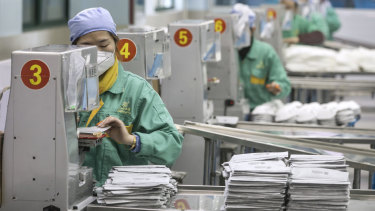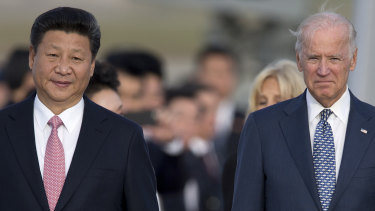Stephen Bartholomeusz
 Donald Trump’s coronavirus fuelled trade wars have started the process of remaking global supply chains with the express purpose of reducing the West's over-reliance on China’s low-cost but highly skilled manufacturing base.
Donald Trump’s coronavirus fuelled trade wars have started the process of remaking global supply chains with the express purpose of reducing the West's over-reliance on China’s low-cost but highly skilled manufacturing base.
It's a process that's gathering pace, buoyed by the decoupling of the US and, increasingly, other economies from China and the rising political antagonism between the western powers and Beijing.
Face mask production at a factory in Shanghai. The pandemic has exposed the world's reliance on China for critical medical products and technology.CREDIT:BLOOMBERG
Trump’s trade wars, a core element of his "Make America Great Again" platform, have delivered on their core promise. His tariffs may have just been a tax on US companies and had little meaningful impact on China’s economy but what they have done is coerce and incentivise US companies to diversify their supply chains.
Vietnam, Taiwan, Mexico and Europe have been the main beneficiaries as US companies shifted rather than "re-shored" their sources of supply.
The pandemic, which initially shut down China’s manufacturing base, reinforced the risks for multinationals of being overexposed to one source of supply and, as the pandemic spread, revealed how dependent the rest of the world had become on China for the most basic – and most critical – of medical supplies and equipment.
China’s increasingly confident challenge to America’s global political and economic hegemony has also spawned another layer of backlash from the West, best encapsulated by the spread of the bans on the use of Huawei’s 5G technology in western wireless networks.
The US, Australia and, most recently, the UK have all excluded Huawei from the rollouts of the new networks on security grounds. That entails significant cost – Huawei has both the industry-leading 5G technologies and is the low-cost provider by some margin. In the UK, Huawei kit within the existing 4G networks will also have to be removed, at great cost, by 2027.
The US crackdown on other Chinese tech companies and individuals on security grounds are part of a wider pushback by the West to China’s ambitions – encapsulated in its "Made in China 2025" policy – to dominate the technologies of the 21st century.
The increased tensions in the South China Sea, suspicion of the motivations behind the Belt and Road Initiative, the new security laws in Hong Kong and its treatment of the Uighurs are all part of a swirling mix of responses to China’s increasingly naked and aggressive ambitions.
Had Trump not fractured old Western alliances, assaulted the global institutions and norms that bound them and included US allies in his protectionist "trade wars on everyone" the Western response to what have been dubbed China’s “predatory geo-economics” might have been more cohesive and powerful.
Could Biden change the game?
The prospect of a Joe Biden presidency and a restoration of a more conventional and less erratic White House administration, one more committed to good relations with its post-war allies, could produce a less disjointed collective pushback to China’s expansion.
The Democrats are, if anything, even more hostile to China than the Trump administration, whose policies have waxed and waned according to Trump’s fluctuating moods and personal interactions with Xi Jinping, which have reportedly included a plea for help with his re-election.
Their agenda on China is likely to be more coherent, and involve closer co-operation with US allies – recreating a powerful trans-Atlantic alliance against China’s more aggressive ambitions – than Trump’s.

China has fast become a top election issue as President Donald Trump and Democrat Joe Biden, pictured with Chinese President Xi Jinping, engage in a verbal brawl over who's better at playing the tough guy against Beijing. CREDIT:AP
They are also more likely to recommit the US to global institutions like the World Trade Organisation and World Health Organisation and – like Australia – engage more directly in the efforts to reform and modernise them.
The pandemic’s disruption to supply chains has also added an edge to the previous discussions about diversifying and re-shoring supply chains and is producing some significant action.
In Japan, for instance, the Abe government has recently set aside $US2.2 billion to provide incentives for Japanese to “re-shore” activity from China and has offered a smaller amount to companies that relocate production elsewhere.
The US has indicated it is prepared to spend a similar amount to Japan on stimulus packages that would promote the re-shoring of manufacturing activity and jobs. It has spent billions to encourage US companies to produce medical supplies and equipment.
Most Western economies, including Australia, are contemplating creating domestic manufacturing of products like personal protection equipment, medical technology and pharmaceuticals previously sourced from China.
Japan and the US are looking to reduce their overdependence on China for the rare earths critical to many existing and new technologies and defence equipment.
The US, UK , Australia and Canada are offering safe haven to wealthy Hong Kong citizens and countries in the region – including Japan, Australia and Singapore – are starting to contemplate how they might displace Hong Kong in its role as a key global financial centre, or at least bolster their standing and weight as regional financial hubs.
Weighing up the costs of decoupling
Until the trade wars, and then the pandemic, China’s dominance of global manufacturing and its emergence as the anchor point for global supply chains was built on its low costs and increasingly skilled capabilities. Its ambition to dominate key 21st century technologies reflects its rising standards of living and labour costs and the demographic challenges looming from three decades of birth control policies.
In the near term, perhaps even in the long term, China’s economy won’t be decoupled from America’s, let alone those of the rest of the Western world.
There would be enormous costs and dislocations for companies to disengage from China and the sheer size and growing affluence of China’s domestic market are too seductive for western companies to ignore.
China’s dominance of manufacturing, however, was already waning even before Trump initiated his trade war. Partly because it was no longer as low cost a jurisdiction as other countries in the region and partly because of a deliberate shift by its authorities away from mercantilism and towards domestic consumption, in a bid to tackle the imbalances in their economy and financial system in ae post-financial crisis environment.
If the US can restore its relationships and regain trust with its former allies, most importantly those in the European Union, it could, however, exploit the legacies of the trade wars, the pandemic, the suspicion of China’s ambitions and its methods for pursuing them to limit its ability to execute its Made in China 2025 and Belt and Road policies.
No comments:
Post a Comment